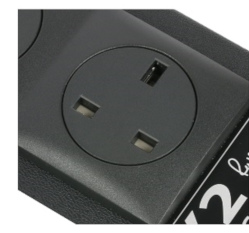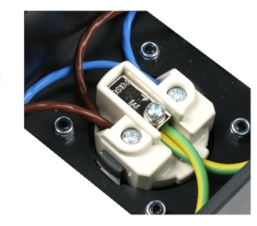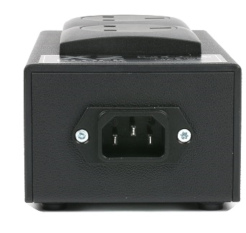Most of us need to use a mains extension to connect our system to the wall socket. Extensive testing has shown us that ordinary extension blocks can degrade the sound of your system – factors such as build quality, the materials used and the design of the cable attached will have an impact on the sound, for example, by having poor contacts that increase impedance.
This article looks at how we address these issues by examining each of the different elements that make up our mains extensions.
Sockets

One of the most important parts of a mains extension are the sockets that your cables plug into. The material the contacts are made from, the plating material (if any) used on those contacts, and how they grip the plug pins are all important. Whether they are switched or not also has a bearing on the sound.
The most common types of sockets that we supply in our extensions are the UK 13A type: we can also supply the European ‘Schuko’ and US type for customers outside the UK.
Traditionally, the performance of UK plugs and sockets has lagged behind that of the Euro and US equivalents, but in recent years the new AQ mains plugs and the new sockets we’ve been using in our extensions has lifted the performance of these plugs and sockets for those of us in the UK.
We use three different types of sockets on our UK mains blocks – good quality outlets used in the PowerBars™ which feature copper alloy contacts; higher performance UltraSockets™, used in the X-Blocks™, which feature a higher contact connection and nickel plated earth terminals - along with Deep Cryogenic Treatment (DCT); and our very best Audio Quality Signature™ sockets in the Signature PowerBlock™, which are rhodium plated throughout and treated with our exclusive Process Q™.
None of the sockets feature switches – we have found that switches degrade performance by increasing the mains impedance.
Wiring

The way the sockets are linked together in the extension is also an important consideration. Our extensions have sockets that are connected with wire as opposed to metal busbars, which are used in some other extensions: we have access to high performance wire (including some of Kimber’s internal wire made specifically for these sort of applications) and special processes to ensure a low-impedance connection.
Our very best block – the Signature PowerBlock™ – also uses an innovative internal distribution circuit to ensure identical current delivery to each of the sockets.
Surge protection and power conditioning
It makes sense to combine surge protection with the block - it offers both a level of protection for your system and has performance benefits too. The components are fitted internally which means that all outlets benefit and you are not using up a socket plugging in a stand-alone SuperClamp™ or MegaClamp™.
SuperClamps™ are an optional extra on the PowerBar™; they are fitted as standard in the XBlocks™. To maintain performance, we recommend refurbishment of SuperClamp™ components every five years - contact us for details.
The MegaClamp™ is standard on the Signature PowerBlock™.
X-Blocks™ also benefit from our Silencer™ mains filter (though a non-filtered X-Block™ is available to special order if, for example, you want to use the X-Block™ in conjunction with Balanced Mains).
The Signature PowerBlock™ does not feature any filtering other than the MegaClamp™; it is designed to be used with the stand-alone PowerPurifier™ which brings together all of the different filtering devices in a convenient unit and can be plugged into the block.
Connecting to the wall socket

Clearly, the connection of your mains extension to the wall socket is important too. All our extensions are fitted with an input socket and not supplied with a cable; this allows you to choose the best cable type and length to suit you and your system.
A standard IEC socket is fitted to the PowerBar™ and X-Blocks™, and the better-performing 16A high current IEC socket is fitted to the Signature PowerBlock™.
Our extensions have been designed to work at their best when fitted with any of our RFI-cancelling woven power cables – from the yellO Power™ to PowerKords™ and SuperKords™.
Any of them will work well, but as a guide PowerBars are most often partnered with yellOs or Evolution-100 PowerKords™; X-Blocks™ with Evolution-100 and Evolution-300 PowerKords™; and Signature PowerBlocks™ with Evolution-500 PowerKords™ and EVO-S PowerKords™.
Extension capacity & 'Star Powering'

We’re often asked whether plugging a full Hi-Fi system into one of our mains extensions will overload it, and if it’s safe to do so. The simple answer is yes, it’s perfectly safe. All of our mains extensions are designed to deal with much higher current levels than you will ever get in a domestic Hi-Fi system.
We measured (relatively power-hungry) Quad system comprising a CD player, turntable, tuner, tape deck, preamp and two valve power amps and found that it drew just over 1A amp when running. You could easily power TEN such systems from one of our mains extensions and you still wouldn’t reach the rating of the extension.
Our power cables and extensions are all rated at 13A and there is a huge margin built in for safety. And it actually makes good sense to connect all of your Hi-Fi components in your Hi-Fi into an single extension – as well as being neat and convenient, using an extension block means that your system is connected to your mains circuit at a single point. We’ve found that this sounds better than connecting your system’s mains leads to several wall sockets at different points of the mains circuit.
Tell me more about PowerBars™
Tell me more about X-Blocks™
Tell me more about Signature PowerBlock™






















